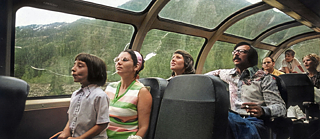What is man-made climate change and why is a temperature rise of more than 1.5 degrees Celsius so dangerous? An overview.
The media and politicians often talk about climate change or the climate crisis. Knowledge about the climate crisis is often taken for granted. However, recent studies show that one in four Germans is not aware that human activity is the main cause of climate change. And almost half of Germans (42%) do not know how dangerous a global temperature rise of more than 1.5 degrees Celsius above pre-industrial levels can be. So let's go over some of the basics.
What is the climate crisis?
The climate crisis is also known as climate change or global warming. It refers to the global rise in temperature. Since industrialization over 100 years ago, the average temperature on Earth has been rising. The reason for the rise in temperature is the increasing production of greenhouse gases, which are emitted into the air.The warming of the Earth by greenhouse gases is caused by the greenhouse effect. The greenhouse effect works as follows: When the sun's rays hit the Earth, some of them are bounced back into the sky as heat rays. Greenhouse gases prevent some of the heat rays from escaping into space. They send them back to Earth. In simple terms, greenhouse gases can be thought of as a blanket that keeps one from freezing at night.
Greenhouse gases are not fundamentally a bad thing. Without greenhouse gases, the Earth's average temperature would be well below 0 degrees Celsius. The sun's rays alone are not enough to support life on Earth. Greenhouse gases - our blanket - make life on Earth possible in the first place.
So the problem is not that there are greenhouse gases, but that there are too many greenhouse gases being released into the air. Because of all the greenhouse gases, our blanket is getting thicker and thicker - it's getting warmer and warmer. (And what is more annoying than a thick blanket on a hot summer night?)
Infobox:
Greenhouse gases are gases that change the climate. CO2, methane, and nitrous oxide are greenhouse gases. The word "greenhouse gas" comes from the word "greenhouse". Greenhouses are glass buildings where plants are grown. The temperature inside greenhouses is very warm because the sun heats the greenhouse.
Just like in a greenhouse, greenhouse gases keep the air in our atmosphere warm. However, the physical process is different from what happens in a greenhouse.
Greenhouse gases are gases that change the climate. CO2, methane, and nitrous oxide are greenhouse gases. The word "greenhouse gas" comes from the word "greenhouse". Greenhouses are glass buildings where plants are grown. The temperature inside greenhouses is very warm because the sun heats the greenhouse.
Just like in a greenhouse, greenhouse gases keep the air in our atmosphere warm. However, the physical process is different from what happens in a greenhouse.
Why is the climate crisis man-made?
There is the natural and the man-made greenhouse effect. The natural greenhouse effect includes our breathing, for example. We breathe in oxygen and breathe out the greenhouse gas CO2. Trees, moors etc. can then absorb this CO2 again and convert it into oxygen. This creates a natural cycle.Since industrialization, however, humans have produced more greenhouse gases than nature can absorb. This happens, for example, through heating and electricity from coal, gas and oil, through cars with internal combustion engines, and through more intensive agriculture. All of this causes more and more greenhouse gases to be released into the air. This creates the man-made greenhouse effect and thus man-made climate change. More than 99% of scientists agree that climate change is caused by humans.
So what are we doing to combat climate change?
As nature and humans are unable to adapt to the rapid climate change, almost every country in the world has signed an agreement: The Paris Climate Agreement. The countries want to hold “the increase in the global average temperature to well below 2°C above pre-industrial levels” and pursue efforts “to limit the temperature increase to 1.5°C above pre-industrial levels.”A temperature rise of 1.5 or 2 degrees Celsius does not sound dangerous at first. But it can be a real threat to life on Earth. Let's compare the rise in temperature to a human fever. If someone has a fever of 40 degrees, they may not feel well, but it is not necessarily dangerous. However, just one degree more, a fever of 41 degrees, can be life-threatening. The body is no longer able to cope with that kind of temperature. This example can be applied to life on Earth and climate change.
September 2024



